The Lady of Shalott è un poemetto romantico scritto dal poeta inglese Alfred Tennyson incentrato su una Dama del ciclo arturiano, condannata da una maledizione a restare prigioniera in una torre senza manco poter guardare il mondo dalla sua finestra.
The Lady of Shalott is a romantic poem written by the English poet Alfred Tennyson focused on a Lady of the Arthurian subject, condemned by a curse to remain a prisoner in a tower without even being able to look at the world from her window.
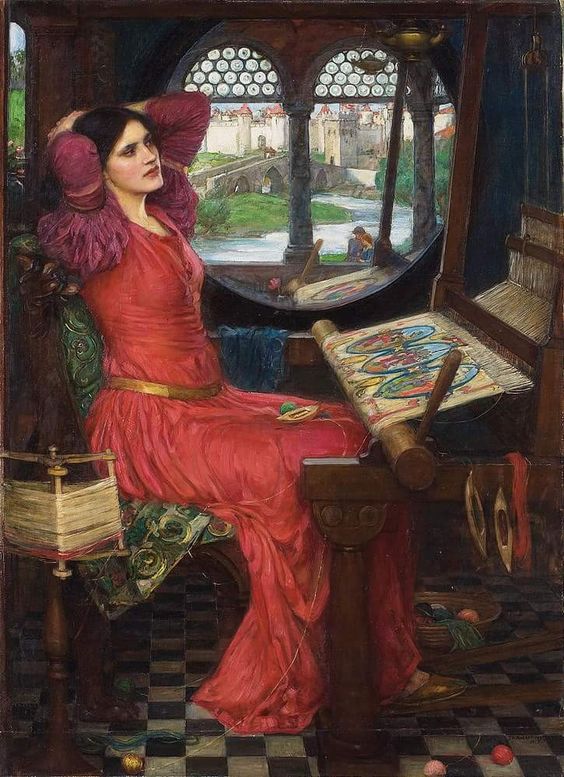
Elaine è il suo nome, figlia di Bernard di Astrolat (Escalot, Ascolat): così nella Novella LXXXII si narra della morte di crepacuore della Dama di Scalotta, innamorata non corrisposta di Lancillotto.
Nelle prime versioni della leggenda non si parla però della maledizione.
Elaine is her name, daughter of Bernard of Astrolat (Escalot, Ascolat): so in the Novella LXXXII it is told of the death of heartbreak of the Lady of Scalotta, in love with Lancelot.
In the early versions of the legend there is no mention of the curse.
LA NOVELLA MEDIEVALE
Medieval Novella
La Dama soccorre amorevolmente Lancillotto ferito gravemente in un torneo, ma viene trattata con freddezza dal Lancillotto guarito. Respinta e offesa chiede al padre di esaudire le sue ultime volontà: vuole essere adagiata in una barca riccamente addobbata e lasciata alla corrente del mare. La navicella viene guidata dalla corrente fino a Camelot dove tutta la corte è attirata da tanto fasto e legge la lettera in cui la dama spiega il motivo della sua morte “A tutti i cavalieri della tavola rotonda, manda salute questa damigella di Scalot, siccome alla miglior gente del mondo. E se voi volte sapere perch’io a mio fine sono venuta, si è per lo migliore cavaliere del mondo e per lo più villano, cioè monsignore messer Lancillotto de Lac, ch’elli avesse di me mercede. E così lassa son morta per bene amare, come voi potete vedere” (da qui)
The lady take care Lancelot wounded seriously in a tournament, but is treated coldly by the healed Lancelot. Rejected and offended she asks her father to grant her last wishes: she wants to be laid down in a richly decorated boat and left to the current of the sea. The ship is guided by the current up to Camelot where the whole court is attracted by so much splendor and reads the letter in which the lady explains the reason for her death
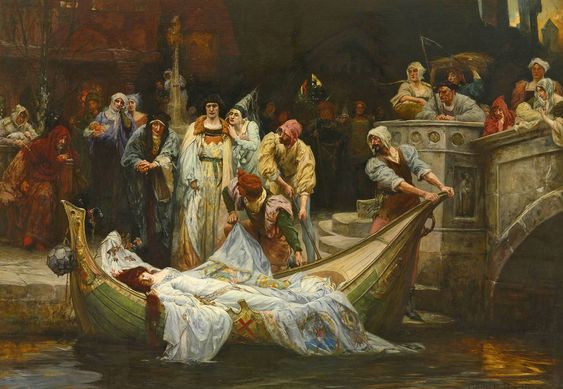
LA VERSIONE DI THOMAS MALORY
Thomas Malory version
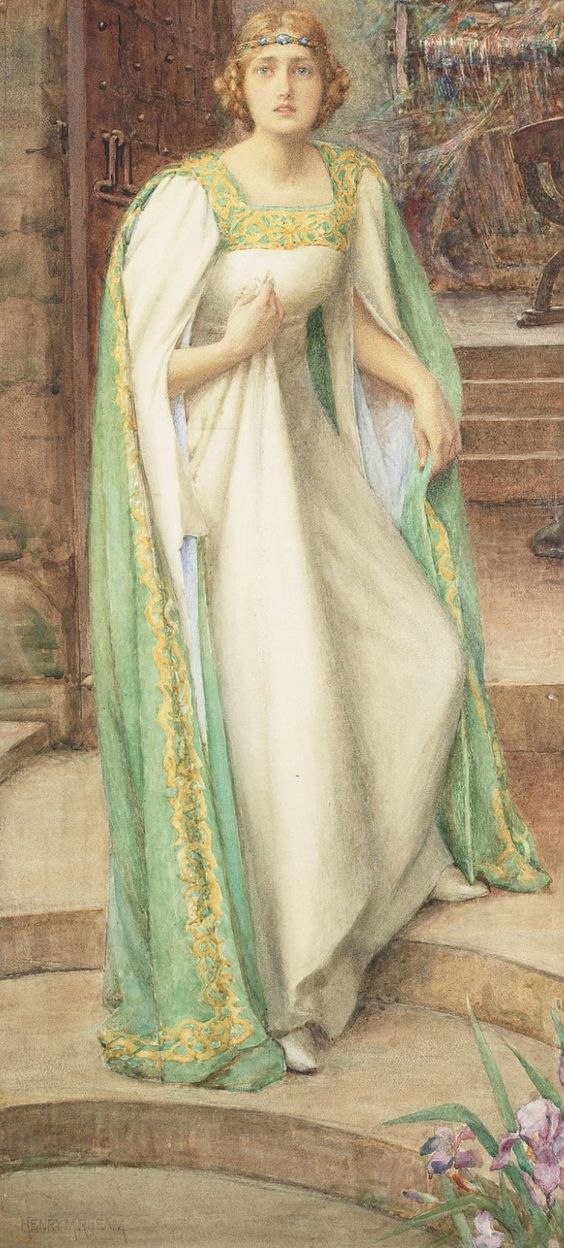
Il racconto è stato ripreso nel XV secolo da Thomas Malory (La Morte di Artù) che ricama parecchio sull’attrazione fatale di Passarosa (dal francese Passerose la malvarosa) la figlia del valvassore di Escalot, presso il quale alloggiano una sera messer Galvano e il suo seguito.
The story was taken over in the fifteenth century by Thomas Malory (Le Morte d’Arthur =The Death of Arthur) who embroidered a lot on the fatal attraction of Elaine the daughter of the vavasour of Escalot, where they lodged one evening Messer Galvano and his follow-up.
Così ce la descrive “i capelli più lucenti d’un nappo d’oro, intrecciati con galloni d’oro e di seta, la pelle bianca e tenera come la neve che cade, gli occhi brillanti come quelli d’un falco di montagna, ma ridenti; della sua beltà la sala era tutta illuminata!“ (tratto da qui)
Lancillotto ha accettato di combattere al torneo indossando sull’elmo la manica di Passarosa, ma alla fine la respinge perchè già innamorato di Ginevra.
La storia prosegue come da copione e la barca porta il corpo esanime della dama che reca con sè la lettera d’accusa questa volta diretta a Lancillotto stesso.
Lancelot has agreed to fight at the tournament wearing the sleeve of Elaine on the helmet, but in the end he rejects her because he is already in love with Geneva.
The story continues as expected and the boat carries the dead body of the lady who carries the letter of accusation with herself, this time directed to Lancelot.
Tutta la materia sulla Lady Shalott è ulteriormente rielaborato da Tennyson nel 1833 (con una seconda stesura nel 1842).
All the material on Lady Shalott is further reworked by Tennyson in 1833 (with a second draft in 1842)
LA MALEDIZIONE DI MORGANA
Morgana’s course
La storia pone Shalott in un isolotto in mezzo al fiume Avon che attraversa più oltre la turrita Camelot, Lancillotto è quasi sempre lontano per riuscire a resistere alla passione per Ginevra.
The story puts Shalott in a small island in the middle of the river Avon that crosses the turreted Camelot, Lancelot is almost always far away to be able to resist the passion for Geneva.
La piccola Elaine è stata maledetta da Morgana quando era ancora in gestazione nel ventre materno. Morgana aveva avuto una visione, Lancillotto si sarebbe innamorato di Ginevra, ma una volta incontrato Elaine non avrebbe potuto fare a meno di amarla. Così però Artù non avrebbe mai sorpreso la moglie Ginevra tra le braccia di Lancillotto. Come ogni fiaba che si rispetti, la madre la chiude fin da bambina in una torre, sperando di proteggerla tragico destino di amore – morte.
Little Elaine was cursed by Morgana when she was still in her mother’s womb. Morgana had a vision, Lancelot would fall in love with Geneva, but once he met Elaine he could not help but love her. So Arthur would never have surprised his wife Ginevra in the arms of Lancelot. Like any self-respecting fairy tale, her mother closes her up in a tower as a child, hoping to protect her tragic destiny of love – death.
Elaine cresce con la consapevolezza che un solo sguardo verso il castello di Camelot sarebbe stato la sua rovina e così passa i suoi giorni, osservando la vita nel riflesso di uno specchio riportando ciò che vede in un arazzo dai vivaci colori.
Elaine grows with the awareness that a single glance towards the castle of Camelot would be her downfall and so she spends her days, observing life in the reflection of a mirror, bringing back what she sees in a brightly colored tapestry.
Aveva 22 anni quando Lancillotto decise di ritornare a Camelot, in un pomeriggio d’estate cavalca al passo davanti alla Rocca di Shalott e non appena Elaine vede Lancillotto nello specchio, spinta dall’amore e dal desiderio di ammirarlo (e forse anche dalla speranza di essere guardata da lui) si affaccia alla finestra: ma lo sguardo inesorabilmente cade su Camelot e lo specchio si spezza. Di nulla si accorge Lancillotto che prosegue il viaggio verso Camelot.
She was 22 years old, when Lancelot decided to return to Camelot: on a summer afternoon he is riding nearby the Rock of Shalott and as soon as Elaine sees Lancelot in the mirror, she is driven by love and the desire to admire him (and perhaps also she hopes of be watched by him) looks out the window: but her gaze inexorably falls on Camelot and the mirror breaks. Nothing is noticed by Lancelot who continues his journey to Camelot.
Elaine invece in attesa della morte, finalmente esce dalla sua prigione dorata, si stende su una barca sulla quale scrive “La Signora di Shalott” e si abbandona alla corrente cantando per l’ultima volta.
Elaine, on the other hand, awaiting her death, finally go away from her golden prison with a boat on which she wroted “The Lady of Shalott”: lulled by the river, she is singing for the last time.
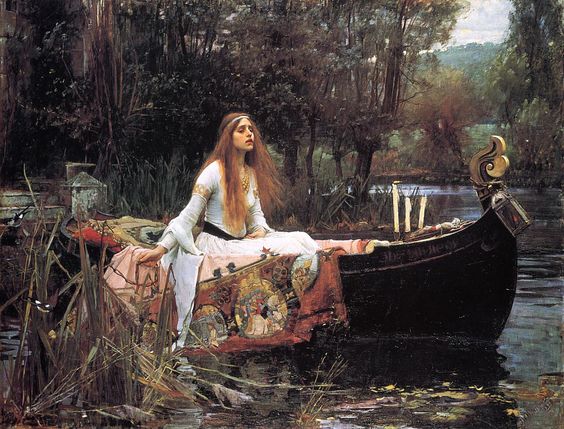
Loreena McKennitt The Lady of Shalott in The Visit 1991
I On either side of the river lie Long fields of barley and of rye, That clothe the wold and meet the sky; And thro’ the field the road runs by To many-towered Camelot (1); And up and down the people go, Gazing where the lilies blow Round an island there below, The island of Shalott. II Willows whiten, aspens quiver, Little breezes dusk and shiver Thro’ the wave that runs for ever By the island in the river Flowing down to Camelot. Four grey walls, and four grey towers, Overlook a space of flowers, And the silent isle imbowers (2) The Lady of Shalott (3). III Only reapers, reaping early, In among the bearded barley Hear a song that echoes cheerly From the river winding clearly Down to tower’d Camelot; And by the moon the reaper weary, Piling sheaves in uplands airy, Listening, whispers “‘tis the fairy The Lady of Shalott.” IV There she weaves by night and day A magic web with colours gay, She has heard a whisper say, A curse is on her if she stay To look down to Camelot. She knows not what the curse may be(4),/And so she weaveth steadily, And little other care hath she, The Lady of Shalott. V And moving through a mirror clear That hangs before her all the year, Shadows of the world appear. There she sees the highway near Winding down to Camelot; And sometimes thro’ the mirror blue The Knights come riding two and two. She hath no loyal Knight and true, The Lady Of Shalott. VI But in her web she still delights To weave the mirror’s magic sights, For often thro’ the silent nights A funeral, with plumes and lights And music, went to Camelot; Or when the Moon was overhead, Came two young lovers lately wed. “I am half sick of shadows,” said The Lady Of Shalott. VII A bow-shot from her bower-eaves, He rode between the barley sheaves, The sun came dazzling thro’ the leaves, And flamed upon the brazen greaves Of bold Sir Lancelot (5). A red-cross knight for ever kneel’d To a lady in his shield (6), That sparkled on the yellow field, Beside remote Shalott. VIII His broad clear brow in sunlight glow’d; On burnish’d hooves his war-horse trode; From underneath his helmet flow’d His coal-black curls as on he rode, As he rode back to Camelot. From the bank and from the river He flashed into the crystal mirror, “Tirra Lirra ( 7),” by the river Sang Sir Lancelot. IX She left the web, she left the loom, She made three paces taro’ the room, She saw the water-lily bloom, She saw the helmet and the plume, She looked down to Camelot. Out flew the web and floated wide; The mirror cracked from side to side; “The curse is come upon me,” cried The Lady of Shalott. X (/8) In the stormy east-wind straining, The pale yellow woods were waning, The broad stream in his banks complaining. Heavily the low sky raining Over towered Camelot; Down she came and found a boat Beneath a willow left afloat, And round about the prow she wrote The Lady of Shalott XI And down the river’s dim expanse Like some bold seer in a trance, Seeing all his own mischance – With a glassy countenance Did she look to Camelot. And at the closing of the day She loosed the chain and down she lay; The broad stream bore her far away, The Lady of Shalott. XII Heard a carol, mournful, holy, Chanted loudly, chanted lowly, Till her blood was frozen slowly, And her eyes were darkened wholly, Turn’d to towered Camelot. For ere she reach’d upon the tide The first house by the water-side, Singing in her song she died, The Lady of Shalott. XIII Under tower and balcony, By garden-wall and gallery, A gleaming (9) shape she floated by, Dead-pale between the houses high, Silent into Camelot. Out upon the wharfs they came, Knight and Burgher, Lord and Dame, And round the prow they read her name,/”The Lady of Shalott”. XIV Who is this? And what is here? And in the lighted palace near Died the sound of royal cheer; And they crossed themselves for fear, All the Knights at Camelot; But Lancelot mused a little space He said (10), “She has a lovely face; God in his mercy lend her grace, The Lady of Shalott.” |
Traduzione italiano di Cattia Salto* I Sulle rive del fiume si stendono vasti campi di orzo e segale che rivestono la terra fino a incontrare il cielo; e attraverso i campi corre la strada verso la turrita Camelot; e la gente va e viene, guardando dove i gigli sbocciano attorno all’isola laggiù in basso, l’Isola di Shalott. II Salici sbiancati, pioppi tremuli, alle lievi brezze del crepuscolo fremono nella corrente che scorre perpetua intorno all’isola nel fiume, fin verso Camelot. Quattro mura grigie e quattro torri grigie sovrastano un prato di fiori, e l’isola silenziosa protegge la Signora di Shalott. III Solo i mietitori, falciando mattinieri, nell’orzo barbuto, odono un canto che riverbera gaio dal fiume sinuoso e limpido verso la turrita Camelot. E sotto la luna lo stanco mietitore, ammucchiando covoni sull’altipiano ventilato, ascoltando sussurra «È della maga la Signora di Shalott». IV Lì tesse giorno e notte una magica tela dai colori gai. Aveva sentito mormorare che una maledizione l’avrebbe colpita se avesse guardato verso Camelot. Non sapeva quale fosse la maledizione, e così tesseva assiduamente, ed altre preoccupazioni non aveva, la Signora di Shalott. V E muovendosi attraverso uno specchio lucido/ appeso di fronte a lei per tutto l’anno, le ombre del mondo appaiono. Lì vede la vicina strada maestra snodarsi verso Camelot; ed a volte attraverso lo specchio azzurro, i Cavalieri vanno cavalcando a due a due: lei non ha un Cavaliere leale e fedele, la Signora di Shalott. VI Ma con la tela ancor si diletta a tessere le magiche immagini dello specchio, perché spesso nelle notti silenti un funerale con pennacchi e luci e musica andava a Camelot; o quando la luna era alta, venivano due innamorati appena sposati «Mi sto stancando delle ombre» disse la Signora di Shalott. VII A un tiro d’arco dal suo balcone lui cavalcava tra i covoni d’orzo. Il sole filtrava abbagliante attraverso il fogliame, e splendeva sui gambali di ottone del prode Messer Lancillotto. Un cavaliere crociato perpetuamente inginocchiato ad una dama sullo scudo, che scintillava sul campo dorato, vicino alla remota Shalott. VIII La fronte ampia e chiara scintillava al sole; su zoccoli bruniti il suo destriero trottava; dall’elmo fluirono i suoi riccioli neri come il carbone, mentre cavalcava, cavalcava di ritorno a Camelot. Dalla riva e dal fiume brillava nello specchio di cristallo, “Tirra lirra” presso il fiume cantò Messer Lancillotto. IX Lasciò la tela, lasciò il telaio, fece tre passi nella stanza, vide le ninfee in fiore, vide l’elmo ed il pennacchio, e guardò verso Camelot. L’ampia tela volò via fluttuando; lo specchio si spezzò da parte e parte «La maledizione mi ha colta» urlò la Signora di Shalott. X Sotto il tempestoso vento dell’est che sferzava i boschi giallo pallido scomparivano, l’ampio fiume si lamentava nel suo greto. Dal cielo basso la pioggia scrosciò sopra la turrita Camelot; lei discese e trovò una barca ormeggiata sotto a un salice, e sulla prua scrisse la Signora di Shalott. XI Ed oltre la pallida distesa del fiume come un’audace veggente in estasi, che contempli tutta la propria mala sorte, con una espressione vitrea guardò verso Camelot. E sul finir del giorno mollò gli ormeggi, e si distese: l’ampio fiume la portò assai lontano, la Signora di Shalott. XII Si udì un inno triste, santo/cantato forte, cantato piano/finché il sangue le si freddò lentamente e gli occhi , rivolti alla turrita Camelot, si oscurarono completamente. Prima che, portata dalla corrente, raggiungesse la prima casa lungo l’argine, canticchiando il proprio canto morì, la Signora di Shalott. XIII Sotto la torre ed il balcone accanto al muro del giardino e al portico lei galleggiava, figura splendente di un pallor mortale, tra le case alte, silente dentro Camelot. Vennero sulla banchina Cavalieri e cittadini, Signori e Dame e intorno alla prua lessero il suo nome “La Signora di Shalott”. XIV Chi è costei? E cosa ci fa qui? Nel vicino palazzo illuminato si spensero i festeggiamenti della Corte e, per la paura, si fecero il segno della croce tutti i cavalieri di Camelot. Lancillotto rifletté un attimo e disse «Ha un bel viso; Dio misericordioso le ha concesso la pace/ la Signora di Shalott». |
NOTES
rielaborata da qui e qui
(italian translation reworked by here and here)
Per la traduzione in rima baciata di Valentino Szemere qui
Sulle due rive del fiume lento
spighe d’orzo e segale in fermento
Dalla brughiera al cielo nel vento.
Corre la strada come un nastro argento
Verso le torri di Camelot
Avanti e indietro passa la gente
E guarda i gigli indifferente
Sulla riva che fende la corrente
Dell’isola di Shalott
Valentino Szemere translation here
1) dimora leggendaria di re Artù e i Cavalieri della Tavola Rotonda (legendary home of King Arthur and the Knights of the Round Table)
2) embower
3) Tennyson non ci dice mai il nome della dama, del resto lei è la donna che incarna l’ideale maschile della donna ottocentesca: passiva e remissiva, destinata a condurre una vita relegata nei confini della casa (Tennyson never tells us the name of the lady, after all she is the woman who embodies the masculine ideal of the nineteenth-century woman: passive and submissive, destined to lead a life relegated to the confines of the house)
4) letteralmente: quale fosse la maledizione, cioè il motivo della maledizione (literally: what was the curse, that is the reason for the curse)
5) Lancillotto è il campione di re Artù, il migliore tra i cavalieri e il più valente, innamorato di Ginevra (Lancelot is the champion of King Arthur, the best of the knights and the most talented, in love with Geneva)
6) le insegne sullo scudo esprimono il voto del cavaliere: la sua totale devozione alla dama che ha scelto eternamente di servire (the signs on the shield express the knight’s vow: his total devotion to the lady who has eternally chosen to serve)
7) è il canto di gioia dell’allodola, ripreso da Shakespeare, Racconto d’inverno, Atto IV, scena III (it is the song of joy of the lark, taken by Shakespeare, Winter’s Tale, Act IV, scene III: “The lark, that tirra-lirra chants“)
8) appena si avvera la maledizione svanisce il paesaggio solare descritto in apertura, ora sferza un tempo di tempesta e piove (as soon as the curse occurs, the solar landscape described in the opening vanishes, now it lashes a storm and it is raining)
9) altri autori ce la descrivono più puntualmente, vestita di bianco e scintillante d’oro e gemme preziose (other authors describehermore punctually, dressed in white and sparkling with gold and precious gems)
10) in Tennyson Lancillotto vede Elaine per la prima volta solo da morta (in Tennyson Lancelot sees Elaine for the first time only in death)
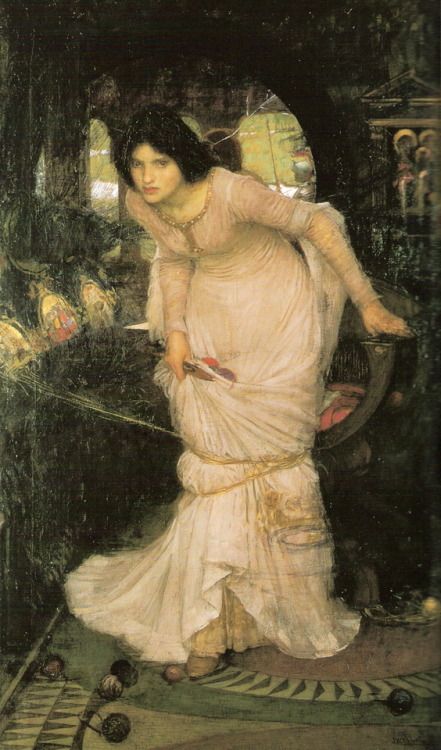
LINK
https://lartedeipazzi.blog/2018/09/16/bretagna-i-sospetti-di-artu-e-la-gelosia-di-ginevra/
https://www.nazioneindiana.com/2010/03/01/amor-cha-nullo-amato-amar-perdona/
http://www.ynis-afallach-tuath.com/public/modules.php?op=modload&name=News&file=article&sid=135
https://www.londonita.com/thomas-malory-e-la-morte-di-artu/
http://qohelet.altervista.org/pagine/Shalott.htm
http://fascinointellettuali.larionews.com/il-mito-di-lady-of-shalott-tra-leggenda-e-poesia-pittura-e-musica/
http://www.missdarcy.it/the-lady-of-shalott-di-tennyson/
